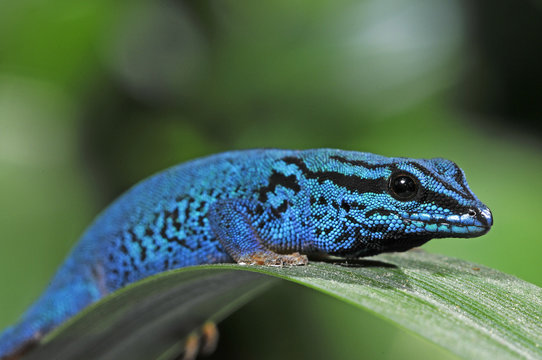ANIMAL: Turquoise Dwarf Gecko/William’s Dwarf Gecko/Electric Blue Gecko Lygodactylus williamsi Type of Animal: Gecko Habitat: Forests (almost exclusively on single screwpine/Pandanus/screwpalm species) Location(s): Found only in 4 small locations in Morogoro region of Tanzania at lowland foothills of Uluguru Mountains Appearance: Males bright electric blue to turquoise w/ heavy black throat stripes, females/subordinate males/juveniles range from brownish to bronze to bright green to copper to olive green w/ turquoise highlights, females/juveniles/subordinate males have black markings on face but lack black on throat, all geckos have orange undersides, very small geckos Food/Diet: Insects, insect larvae, fruit, nectar Status in Wild: Critically Endangered Conservation: Breeding in zoos, wildlife centers, & herpetoculture. Monitoring of restricted habitat. Lifestyle: Solitary or small groups of a male w/ 1-3 females & young/juveniles Additional Info: Called: Male Female Young: Hatchling Group: Leap/Colony Weight: Adult: 0.06 oz Young: 0.03 oz Gestation: 15 weeks Life Span: 5-10 years Body Length: Male: 3 in Female: 2.5 in Young: 0.8 in Tail Length: 1 in Critically endangered due to deforestation, firewood collection, habitat loss/fragmentation, pet trade, restricted range, clearing for agriculture, mining, invasive Celedra trees, & specialized preference for Pandanus rabaiensis. Juveniles stay w/ colony until 3 months old, reaching sexual maturity at 5 months old. Males extremely territorial often fighting to the death. Males court females w/ lateral flattening, puffing of throat pouch, & head bobbing. Both sexes head-bob to assert dominance & defend territory. Females can breed multiple times a year but lay only 1-2 pea-sized eggs per clutch, which are glued to surfaces in secure hidden areas. Active during the day (diurnal). Although trade in wild-caught geckos illegal in most areas, many wild-caught geckos sold in pet stores. Electric blue name refers to male coloration. Like many geckos, webbed feet great for climbing as well as sticking to surfaces. They’re highly arboreal not often coming to the ground. Fun Fact(s): Many wildlife traffickers intentionally mislabel this species (especially as other Lygodactylus species). Though they’re not day geckos, sometimes called Electric Blue Day Geckos. They’re closely related to day geckos though. William’s name honors American herpetologist Ernest Edward Williams. These are very bold & active geckos. Sought after due to coloration. Estimated that 32,310-42,610 geckos taken by 1 collecting group between December 2004-July 2009 (around 15% of population).

